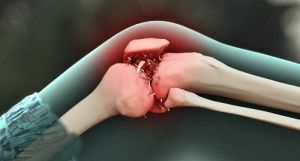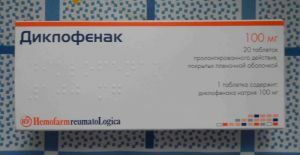 Diclofenac refers to NSAID preparations, acetic acid derivatives and related drugs, the ATX code is M01AB05.
Diclofenac refers to NSAID preparations, acetic acid derivatives and related drugs, the ATX code is M01AB05.
Studies have demonstrated the anti-inflammatory effect of the drug by inhibiting the production of prostaglandins.
The drug relieves pain, swelling and fever due to its anti-inflammatory effect. In addition, Diclofenac inhibits ADP and produces platelet aggregation induced by collagen.
Contents of the article
- Pharmaceutical remedies
- List of active and auxiliary substances
- Therapeutic indications
- Contraindications to prescription
- Dosage and route of use
- Cases of overdose
- Therapeutic actions in case of overdose
- Side effects
- Special warnings and precautions
- Drug compatibility with alcohol
- Function violationliver
- Kidney disorders
- Interaction with other drugs
- Pregnancy, Breastfeeding and Children
- Analyzing reviews, pluses and minuses
- Tips for receiving from patients
- Pros and Cons following from practical application
- Purchasing and storing
- Selecting available analogs
Pharmaceuticals
Following oral administration of the Diclofenac tablet, the drug is completely absorbed from theThe gastrointestinal tract distal to the stomach. The peak concentration in blood plasma is achieved within 1-16 hours.
Oral administration of diclofenac undergoes a significant "first pass" effect, only 35-70% of the dose taken reaches the post-hepatic circulation without changes. Approximately, 30% of the dose is excreted in a metabolized form with feces.
About 70% of the substances are excreted by the kidneys in the form of inactive metabolites after exposure to hepatic metabolism. The half-life is about 2 hours and, first of all, depends on the hepatic and renal function.
List of active and auxiliary substances
Tablets composition Diclofenac:
- diclofenac sodium;
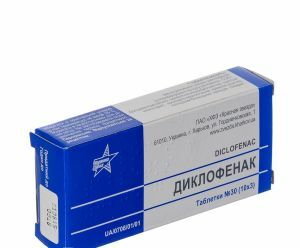
- talcum powder;
- ethylcellulose;
- magnesium stearate;
- Povidone;
- hypromellose;
- diethyl phthalate;
- titanium dioxide;
- red iron oxide;
- stearic acid;
- macrogol 4000.
Tablets of prolonged action, coated with a coating, completely or almost odorless. A box of PVC / PVDC / Al( opaque, white).In the package: 20, 30, 50 and 100 tablets of prolonged action.
Other forms of release: suppositories, solution and preparations for topical treatment( gel and ointment).
Therapeutic indications
Diclofenac in the form of tablets is used for the symptomatic treatment of inflammation and pain with:
- arthritis, chronic and acute( including acute forms of gout and rheumatoid arthritis);

- ankylosing spondylitis;
- other spondylitis;
- disease states resulting from diseases of the spine( osteoarthritis and spondylitis) and joints;
- rheumatism of soft tissues( extra-articular rheumatism);
- painful swelling or inflammation resulting from injuries.
For postoperative or post-traumatic swelling and inflammation, the patient may take Diclofenac without consulting a doctor, other cases require medication only with the consent or recommendation of a doctor.
The release of the drug and the onset of action of diclofenac may be slower. Therefore, the drug should not be used in cases where a rapid onset of action is necessary.
Contraindications to the prescription of
Tablets Diclofenac should not be taken with:
- sensitivity to any of the components;
- if previous reactions with aspirin or other NSAIDs, such as bronchospasm, asthma, rhinitis or urticaria, were present;
- if there is a history of gastrointestinal bleeding or perforation associated with previous NSAID therapy;
- active or anamnestic recurrent ulcer( 2 or more episodes);
- severe heart failure;
- blood clotting or hematopoiesis;
- any active bleeding;
- severe worsening of liver or kidney function;
- in the 3rd trimester of pregnancy.
Dosage and route of administration of
Diclofenac dosage depends on the severity of the disease. The optimal dose for children over 15 years and adults: 50-150 mg of drug per day, divided into 2-3 single doses.
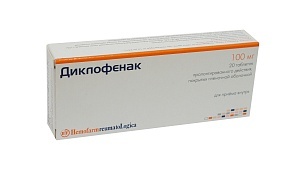 There is no need for dosage adjustment for patients of the age. However, given the profile of possible side effects, it is necessary to carefully monitor the medication, especially in elderly patients.
There is no need for dosage adjustment for patients of the age. However, given the profile of possible side effects, it is necessary to carefully monitor the medication, especially in elderly patients.
For hepatic and renal insufficiency, a mild and moderate form of dose reduction is not required.
Diclofenac tablets are taken whole, not chewing, squeezed with liquid( 1 cup non-carbonated water) on an empty stomach 1-2 hours before meals.
The duration of treatment for a specific patient is determined only by the attending physician! In rheumatic diseases, tablets may be used for a longer period.
Cases of overdose
There is no definite clinical picture. Symptoms may include dizziness, headache, altered consciousness( in children, also myoclonus), nausea and vomiting, gastrointestinal bleeding, diarrhea, ringing in the ears, or convulsions.
Hypotension and cyanosis may also occur.
In cases of poisoning, acute liver failure and / or kidney problems may occur.
Treatment for overdose of
Therapy for NSAID poisoning, including Diclofenac, consists of supportive measures and symptomatic treatment aimed at suppressing complications:
- hypotension;
- renal failure;
- convulsions;
- disorders of the digestive tract.
After ingestion of potentially toxic high doses, removal of the stomach contents( rinsing) is considered.
Side effects of
Possible side effects are usually dose-related, and vary with individual patients. The risk of their occurrence often depends on the dose and duration of the drug.
So the following possible undesirable phenomena:
- Infections and invasions of .Very rarely: exacerbation of inflammation of infectious nature, signs of aseptic meningitis.
- Blood and lymphatic system .Very rarely: thrombocytopenia, anemia, pancytopenia, agranulocytosis. Early symptoms may include: fever, superficial damage in the mouth, severe exhaustion, epistaxis and bleeding( bruises).

- The immune system .Rarely: severe hypersensitivity reactions( anaphylaxis and anaphylactoid reactions).Very rarely: angioedema( tongue, throat and constriction of the respiratory tract), dyspnea, tachycardia, hypotension with deepening of the state in a life-threatening shock, allergic vasculitis and pneumonitis.
- Nervous system .Often: dizziness, irritability, agitation, drowsiness, fatigue, headache.
- Ophthalmic disorders .Very rarely: visual disturbances( amblyopia and diplopia).
- Ear and labyrinth disorders .Often: dizziness. Very rarely: temporary hearing disorders.
- Cardiac disorders .Infrequent: palpitations, heart failure, chest pain, myocardial infarction.(The frequency corresponds to data from long-term treatment with high doses of 150 mg / day).
- Vascular disorders .Very rarely: hypertension, vasculitis.
- of the digestive tract .Very often: diarrhea, vomiting, slight bleeding in the digestive tract. Often: flatulence, abdominal cramps, worsening of appetite. Rarely: gastritis.
Special warnings and precautions
Minimizing adverse effects is possible by taking the minimum dose for the shortest period necessary to inhibit symptoms.
Diclofenac is not assigned together with other systemic NSAIDs because of the lack of evidence indicating synergistic activity and potential for additive adverse reactions.
Like other NSAIDs, diclofenac, because of its pharmacodynamic properties, can mask signs of infectious diseases.
Tablets contain lactose. Patients with rare hereditary disorders, such as galactose intolerances, lactase deficiency or enteropathy, should not take this medication.
Drug compatibility with alcohol
 Alcohol and Diclofenac are incompatible!
Alcohol and Diclofenac are incompatible!
Their combination inhibits the work of the liver.
Aggressive action of these 2 incompatible substances can lead to a decrease in the effect of the drug and unpredictable complications.
The combination of alcohol and medication can cause high blood pressure( hypertension) and increase blood circulation stagnation. This is the cause of intoxication.
The combination of Diclofenac with alcohol affects the central nervous system. If alcohol stimulates the activity of nerve cells, the drug slows it down. This combination can damage the central nervous system and cause symptoms such as pathological fatigue, reduced response to irritants, memory impairment.
Dysfunction of the liver
Like other NSAIDs, diclofenac may increase the values of liver enzymes. For safety reasons, it is necessary to monitor liver function throughout the treatment period.
Discontinuation of the drug is necessary if the abnormal liver function tests, signs of liver disease or other symptoms persist or worsen.
Hepatitis can occur without prior symptoms. Particular care should be given to patients with hepatic porphyria.
Kidney Disturbance
Kidney tissue damage can occur very rarely, some of which can accompany acute renal failure, proteinuria( a protein in the urine) and / or hematuria( blood in the urine).
In very rare cases, a nephrotic syndrome( accumulation of water in the body( edema) and severe proteinuria can develop.)
Decreased diuresis, fluid accumulation in the body and general feeling of malaise may be symptoms of kidney damage that can lead to their failure.
Interaction with other drugs
Diclofenac tablets with other medications taken:
- Other NSAIDs .Simultaneous administration of most NSAIDs may lead to a synergistic effect, increase the risk of bleeding and gastrointestinal ulcers.
- Inhibitors of CYP2C9 .The combination of these drugs can lead to a significant increase in peak plasma levels and inhibition of the metabolism and effects of diclofenac.
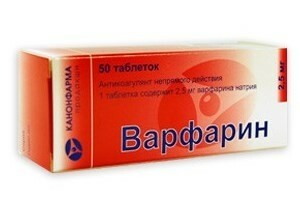
- Antihypertensive drugs and diuretics .Concomitant administration of the drug with antihypertensive agents or diuretics can reduce their antihypertensive effect. For this reason, caution should be exercised in this combination, especially in the elderly, and blood pressure should also be monitored regularly.
- Oral corticosteroids increase the risk of gastrointestinal ulcers and bleeding.
- Anticoagulants( Warfarin) and antiaggregants( Aspirin) .Simultaneous reception may increase the risk of bleeding.
Pregnancy, breastfeeding and children
Inhibiting the production of prostaglandins can adversely affect the course of pregnancy. The results of the studies indicate an increased risk of miscarriage and development of heart defects after taking the drug in 1-2 trimesters. It is indicated that the risk is directly proportional to the dose and duration of therapy.
Diclofenac tablets should not be taken in 1-2 trimesters of pregnancy unless it is absolutely necessary.
If the drug is prescribed to women who are in the 1st or 2nd trimester of pregnancy, the dose and duration of therapy should be minimal. During the 3rd trimester of pregnancy, the drug should not be taken.
 Like other NSAIDs, diclofenac penetrates into breast milk, so it should not be administered during breastfeeding in order to avoid adverse effects on the baby.
Like other NSAIDs, diclofenac penetrates into breast milk, so it should not be administered during breastfeeding in order to avoid adverse effects on the baby.
Use of diclofenac in children and adolescents under 15 years of age is not recommended because there is insufficient experience with the use of the drug in this age group.
In a situation where children are needed, the drug is prescribed to children over 6 years of age, in accordance with 2 mg / kg / day.
Analysis of comments, pluses and minuses
Having studied the reviews of patients and doctors, having analyzed the pros and cons, one can draw conclusions about how effective and safe the Diclofenac tablets are.
After I had pain in my spine and prescribed Diclofenac, I did not notice any side effects. Negative effect on the stomach tablets were not provided, while from painful sensations were relieved instantly!
Olga, 46 years old
Diclofenac helped me to fight the pain, but still, had a definite negative effect on the stomach. The doctor advised to take the tablets with milk. It helped.
Natalia, 38 years old
To date, Diclofenac is the optimal choice for the treatment of various joint disorders. However, before using it, listen to the advice of your attending physician and carefully read the instruction leaflet!
This will help prevent the occurrence of undesirable effects, which are often complained of by patients: Diclofenac has some limitations with regard to combination with other drugs and disorders of certain organs and body systems.
Nicholas, rheumatologist
Tips for receiving patients
I want to say about taking the drug during GW.The instructions are not recommended, but the doctor told me that 1-2 days after taking the drug components completely emerge from the milk. So, decant a couple of days - and feed on! .
Наталия, 28 years old
Observations from own experience: if after taking Diclofenac there are stomach disorders, just take a pill with milk - and there will be no unpleasant sensations! .
Anna, 35 years old
Pros and cons following from the practical application of
The positive aspects of the use of Diclofenac tablets are that it relieves painful 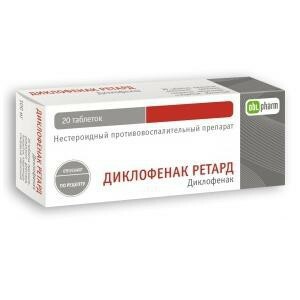 sensations in the joints relatively quickly.
sensations in the joints relatively quickly.
Side effects of the drug can be attributed, both to pluses and minuses.
On the one hand, they are rare, on the other - if it comes to this, the complications are quite bright.
In addition, the negative side of the drug is its low "compatibility" with renal and hepatic insufficiency;In addition to this, cases of adverse effects of Diclofenac on the body of elderly people were observed.
Purchase and storage of
Average price of Diclofenac:
- tablets( 50 mg, 20 pcs.): 45 rub;
- gel( 5%, 50 g.): 95 rubles;
- eye drops( 0.1%, 5 ml.): 30 rubles;
- ampoules( 25 mg / ml, 10 pcs.): 43-50 rubles;
- ointment( 1%, 30 g.): 30 rub.
Shelf life: 4 years. This drug does not require any special storage conditions, it is kept at a temperature of 15-25 ° C.
Leave in pharmacies according to prescription.
Selection of available analogs of
Available following analogues of Diclofenac tablets, some of them cheaper, and some safe: 
- Orthofen .In view of a similar active ingredient, the action is similar to that of Diclofenac.
- Naproxen .Characterized by a broader spectrum of action and fewer side effects.
- Diklak-gel .The drug is a local action. The active ingredient is diclofenac sodium.
- Neurodiculous ( gel, suppositories).Maximum therapeutic effect, minimum side effects.
In Russia, such drugs containing the active ingredient diclofenac sodium, such as: Diclofenac retard, Diclofenac Bufus, Diklovit.


